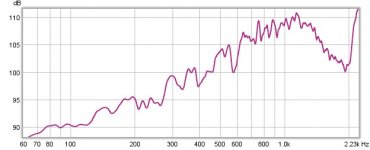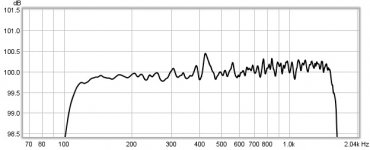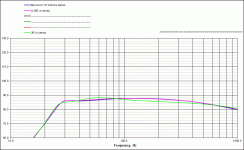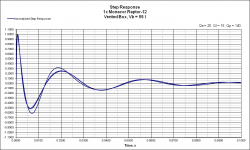In the real world it is because the wire it is made of naturally has DC resistance. But the mathematically perfect model of an inductor is not suppose to have any DC resistance.
In the real world any compentent passive cross-over designer will have the resistance as part of his model.
dave
The other missing bit is sensitivity analysis (in the sense of sensitivity of frequency response to tolerances). The change of frequency response with variations in series R is actually surprisingly small, often swamped by driver to driver tolerances or change in driver parameters with room temperature.
Pick a driver, determine a box for some alignment, then add a few tenths of an ohm to the DCR. What happens? Compare it to small (10%) variations in Qms, fs, or Vas. My guess is that most people who fret about this haven't actually measured or even simmed these effects.
Pick a driver, determine a box for some alignment, then add a few tenths of an ohm to the DCR. What happens? Compare it to small (10%) variations in Qms, fs, or Vas. My guess is that most people who fret about this haven't actually measured or even simmed these effects.
agreed, provided there is no need to match source/load as in tubes that use transformers and rely on impedance reflection to transfer max. power, although the significance would not be tat important given the outrageous speaker behaviour - impedanc wise.
Once again, what are you talking about? Which impedance? Impedance does not matter if it does not go too low for any amp, tube or stone, to cause excess distortions, engage overcurrent protection, or fry output transistors. Impedance curve is never flat, it is bumpy. As soon as the amp+speaker combination has flat frequency response and low distortions it is exactly what we need from this combination. However, some speakers with complex crossovers have nasty dips in impedance, and some of them are even very expensive, but that means lousy design, and lousy design only. They were not designed for "solid state amps", they were designed for something crazy and artificial. No, rather they were not properly designed at all. If speakers have say "8 Ohm" on stickers, they should not have impedance below 8 Ohm on any frequency (well, except DC), on the rest of frequencies it can be much bigger, it does not matter, if amp+speaker combination results in flat frequency response. And if the amp has proper EQ to make frequency response curve flat, even how flat is response of amp+speaker without that EQ does not matter.
Simple, don't use valve amps.
I would prefer not to use crossovers designed by carpenters.
I've never seen a good looking valve amp.
I've had one on BAF 2008. It was used for auditioning of different speakers. No problems to get low, and even negative, output impedance from a tube amp. You just have to design it by some other method than "Cut-n-paste".
Current drive, voltage drive, it really doesn't matter; the driver's real drive requirements can be measured and matched, whether or not the driver is in a big box, little box or no box at all.
This makes it possible to take a speaker with a response like this:

and turn it into a speaker with response like this:

From this vantage point it is rationally possible to measure and observe what happens when multiple drivers are networked together with resistors, capacitors, and inductors. Good results are possible, but these components mostly just get in my way when used in this fashion.
Andrew
This makes it possible to take a speaker with a response like this:

and turn it into a speaker with response like this:

From this vantage point it is rationally possible to measure and observe what happens when multiple drivers are networked together with resistors, capacitors, and inductors. Good results are possible, but these components mostly just get in my way when used in this fashion.
Andrew
CAD modeled freq response tells you nothing of the control the amp has to start and stop the cone motion.
Because it does not start or stop. It supplies current that causes acceleration.
This is what I was asking about earlier. Is there a penalty to creating a driver that apparently gives a flat frequency response when driven with a wacky series impedance?This makes it possible to take a speaker with a response like this:
and turn it into a speaker with response like this:
CAD modeled freq response tells you nothing of the control the amp has to start and stop the cone motion.
Actually, that's exactly what it tells you- the amp can be modeled as a source impedance and variations in it examined (as Pano just showed dramatically). When you compare CAD versus measurement in the bass with real speakers and real amps, it's stunningly accurate.
It does tell you a lot, as SY has mentioned. It's not perfect, but pretty good.CAD modeled freq response tells you nothing of the control the amp has to start and stop the cone motion.
Below is the simulated step response of the same box and driver with the same series R 0R, 0.2R and 2R. You can see that there is about 1dB more overshoot with the 2 Ohm source impedance.
I can do some actual measurements if you like, or you can do them yourself.
No argument that lower output impedance can sound different than high, but it's nice to know why.
Attachments
There are things you can do with active crossovers and multiple amps that you simply cannot do with a single amp and a passive multi-way crossover.
You have total buffering and isolation between the stages.
There is no getting around that.
If there was a total and finite winning argument for single power amp and passive crossover then active multi-amp would not be used in professional audio applications.
It is.
Regularly.
James.
You have total buffering and isolation between the stages.
There is no getting around that.
If there was a total and finite winning argument for single power amp and passive crossover then active multi-amp would not be used in professional audio applications.
It is.
Regularly.
James.
i can't say i did many designs with passive or active.
but there are things that come into my mind.
the series resistance of passive components is kindof the first one, allready pointed out by some.
surely inductors used in a crossover could in theory couple signals between eatch other, something no one would like. clipping of the amplifier driving the woofer will not affect the tweeter. But allso has to mention a system should never be clipping. so thisone is pointless.
CEMF is more intresting, specialy with high sensitivity drivers. here an active design does indeed have its advantage. Component value matching. hard to find trimmable capacitors that can be utilised in a passive crossover, but not hard at all for an active one.
costs are mentioned with active filters as more poweramps are needed. well.. if one takes a look at crossover part prices, it is likely that DIY poweramps may be a lot cheaper.
designing both of them is hard. But active is more felxible from a point of view.
You can't just change an inductor as easyli as get a trimm cap / resistor.
delay alligmenting speakers with passive crossover is managable, but with active allpass filter its just so mutch less of a problem.
from diy point of view the "findling" part is mutch less of a hard task with active filters.
there has gotta be verry good points besides passive filters, but i can't realy think of any.
but there are things that come into my mind.
the series resistance of passive components is kindof the first one, allready pointed out by some.
surely inductors used in a crossover could in theory couple signals between eatch other, something no one would like. clipping of the amplifier driving the woofer will not affect the tweeter. But allso has to mention a system should never be clipping. so thisone is pointless.
CEMF is more intresting, specialy with high sensitivity drivers. here an active design does indeed have its advantage. Component value matching. hard to find trimmable capacitors that can be utilised in a passive crossover, but not hard at all for an active one.
costs are mentioned with active filters as more poweramps are needed. well.. if one takes a look at crossover part prices, it is likely that DIY poweramps may be a lot cheaper.
designing both of them is hard. But active is more felxible from a point of view.
You can't just change an inductor as easyli as get a trimm cap / resistor.
delay alligmenting speakers with passive crossover is managable, but with active allpass filter its just so mutch less of a problem.
from diy point of view the "findling" part is mutch less of a hard task with active filters.
there has gotta be verry good points besides passive filters, but i can't realy think of any.
MichaelThere are things you can do with passives you simply can't do with active
You guys make some of the most beautiful looking speakers in the world. Stunning. O.K., way off topic question; What are the distortion figures like on your single ended planar magnetic tweeter? If you don't mind me asking..Or is it a true ribbon?(The apparent traces may have thrown me off)
Last edited:
There are things you can do with passives you simply can't do with active
Some examples please.....?
- Status
- This old topic is closed. If you want to reopen this topic, contact a moderator using the "Report Post" button.
- Home
- Loudspeakers
- Multi-Way
- Active vrs passive

